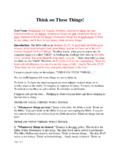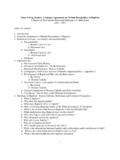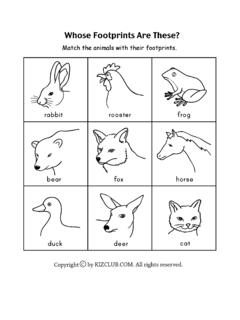Transcription of Ethnicity and Tribalism: are these the Root Causes …
1 Ethnicity and tribalism : are these the Root Causes of the Sudanese Civil Conflicts? African conflicts and the Role of Ethnicity : a Case Study of Sudan By Pamela Paglia TABLE OF CONTENTS. 1. Historical Background of Sudan ..3. The First Civil The Second Civil War ..5. Historical Background of The Darfur Crisis ..6. WHY SHOULD NOT Ethnicity AND tribalism BE CONSIDERED THE. PRIMARY Causes FOR CONFLICT? .. 7. tribalism and Ethnicity : A Theoretical Framework ..7. Ethnicity in Sudan ..13. Constructed Ethnicity and Constructed Conflict ..15. THE ROOT Causes OF AFRICAN CONFLICTS .. 17. The Postcolonial Period ..19. Postcolonial African States and the Emergence of Conflict ..19. Postcolonial African States and the Legacy of Postcolonial African States and the Impact of the Cold War Period.
2 25. Ideologies of the Cold War The Neoliberal Period ..28. Crisis of Postcolonial States and Democratization ..29. SUDAN .. 32. Postcolonial Sudan and the inheritance of colonialism ..32. Sudan and the Postcolonial and Neoliberal Periods ..34. CONCLUSION .. 36. SELECTED I. 2. Introduction When I visited Darfur last May, I felt hopeful. Today I am pessimistic, unless a major new international effort is mustered in the coming weeks (..). I wish I could report that all these efforts had borne fruit - that Darfur was at peace and on the road to recovery. Alas, the opposite is true. People in many parts of Darfur continue to be killed, raped and driven from their homes by the thousands. The number displaced has reached 2 million, while 3 million (half the total population of Darfur) are dependent on international relief for food and other basics.
3 Many parts of Darfur are becoming too dangerous for relief workers to reach. The peace talks are far from reaching a conclusion. And fighting now threatens to spread into neighboring Chad, which has accused Sudan of arming rebels on its territory (..). One thing is clear: Whatever external force is sent to Darfur can provide at best only temporary security to the people there. Only a political agreement among their leaders can secure their future and the return of 2 million of them to their homes. 1. The article by former UN Secretary General Kofi Annan describes with pessimism the unsolved tragedy of Darfur. The headlines of the international press have echoed the toll of the Darfur Tragedy.
4 The 200,000 victims and almost 2 million displaced people have pushed the conflict to the central stage of international issues. In the words of John Danforth, US Ambassador to the UN, this conflict represents the largest humanitarian disaster in the world'.2. The crisis in Darfur is not unusual in the overall African scenario. The whole African continent is in fact still torn apart by many cases of conflict and civil unrest, which hinder the development of many African countries. Rwanda, Sierra Leone, Liberia, Ethiopia and Eritrea, the Democratic Republic of Congo, Nigeria and Somalia are only some examples of the atrocities that afflict the African continent and make peace and stability impossible.
5 Africa is also the continent with the highest rate of poverty, illiteracy, and infant mortality. Numerous international organizations, both governmental and non- governmental, have tried to promote strategies for poverty reduction, economic and social development and crisis management. Africa seems, though, not to respond as well as other parts of the world to the therapy . Since the 1960s, several development and international financial aid programs have tried to address the issues of poverty and underdevelopment in Africa, Asia and Latin America. these programs yielded results in some parts of the world, as for the so-called Asian Tigers - Singapore, Honk Kong, Taiwan, and South Korea.
6 We have also assisted to the exponential growth of the Indian 1. Annan, Kofi, Darfur Descending: No Time For Apathy on Sudan, The Washington Post, Wednesday, January 25, 2006; Page A19. From: 2. Can the African Union Bring Peace To Darfur? , , October 25th, 2004. From: 1. and Chinese economies despite their high levels of corruption. However, similar programs were almost a failure in African countries. Many scholars have rightly argued that political and social instability are a major cause for underdevelopment. Ted Gurr and Monty Marshall have written that most African conflicts are caused by the combination of poverty and weak states and institutions. 3 By poverty, I also imply a scarcity of and therefore a struggle for resources.
7 It is thus fundamental to precisely identify the Causes and factors for instability in order to create successful strategies for the resolution of endemic poverty and underdevelopment in Africa. At a first glance, the media and a large number of scholars and politicians pointed out at Ethnicity and tribalism as the root Causes for conflict. For instance, despite Arab and African ethnic groups were mixed since the VIII century, most literature on the Causes of Sudanese civil conflicts depicts these conflicts as an Arab, Muslim North versus an African, and Christian/Animist South. The distinction is made according to the perceived origins of the two groups, where the Arabs are said to come from Saudi Arabia, and the Africans from African groups, the most ancient of which is the Nubian Ethnicity .
8 In the Darfur conflict, the ethnic division between Arab militias and African tribes has been described as the primary cause for conflict. Indeed, Ethnicity and tribalism have an important role in the conflicts, but emerge only as secondary factors. Concentrating on Ethnicity as the primary cause for conflict underestimates the complexity of African societies and politics, and deviates policymakers' attention from the real Causes of conflict. Ethnicity is a means through which conflicts in many African countries are conducted and a powerful tool for political mass mobilization. Therefore, the main question is: if Ethnicity and tribalism are not the root Causes , what triggers conflict in Africa?
9 My thesis tries to analyze the main features of African conflicts and to take the Sudanese civil conflicts and of the ongoing Darfur crisis as a case study. The thesis tries to give a theoretical framework for Ethnicity , in order to explain that Ethnicity is not conflictive per se and cannot, therefore, cause conflict. The thesis thus attempts to determine the root Causes of conflict, which are to be found in historical patterns of regional marginalization and economic uneven distribution, in the influences of the international context on the local reality, in the political mobilization of Ethnicity by international and local actors, in structural problems, in environmental degradation, and by the failure of state-building, and consequently of nation-building.
10 3. Quoted in: Irobi, Emma Godwin, Ethnic Conflict Management in Africa: A Comparative Case Study of Nigeria and South Africa, May 2005. From: 2. Geography The Republic of the Sudan is a federal republic, which is divided in 26 States. Its population amounts to about 40 million people. Most of the population - 68%4 - is rural. According to the Millennium Development Goals Report, the percentage of rural population increases in the South as 98% of it lives in rural areas. The International Commission of Inquiry on Darfur revealed that the remaining 32% of Sudan's population is urban and 7% nomadic. Historical Background of Sudan The history of Sudan has been strongly influenced by the Arab world since the VII century.








